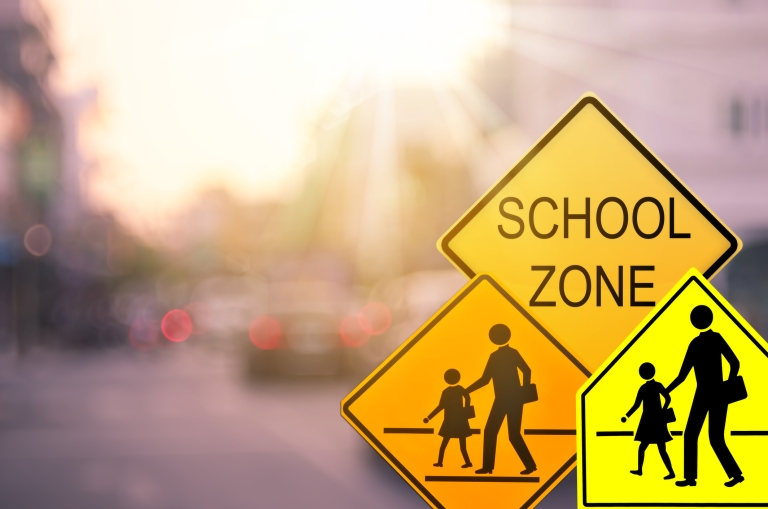
Navigating School Zones: A Guide for New and Seasoned Drivers

Every year, as the school bells ring, signaling the start of a new academic year, roads and neighborhoods around schools become bustling hubs of activity. Parents drop off their kids, school buses make their rounds, and students of all ages walk or bike to their classes. While this scene is a familiar one, it's also a setting where safety becomes paramount. With the rise in pedestrian deaths, especially among teens, understanding and adhering to school zone safety has never been more crucial.
The Alarming Statistics
According to a study by Safe Kids Worldwide the numbers are sobering. In 2015 alone, 284 teens between the ages of 12 and 19 lost their lives while walking. This tragic statistic translates to more than 5 pedestrian deaths every single week. While efforts over the past decades have decreased the pedestrian death rate for children 19 and under, the rate for teens aged 12-19 hasn't seen the same rapid decline. In fact, the past two years witnessed a concerning 13% spike in the pedestrian death rate for this age group.
But why is this happening? One significant factor that has emerged in recent years is the rise of distractions, not just for drivers but also for the pedestrians themselves.
The New Age Dangers: Distracted Walking
Gone are the days when walking meant simply putting one foot in front of the other. Today, the simple act of walking to school can be riddled with distractions, primarily due to mobile devices. A recent study observed that a staggering 27% of high school students and 17% of middle school students were distracted while walking in school zones. The main culprits? Headphones, with 44% of distracted teens using them, followed by texting at 31% and talking on the phone at 18%.
This trend of 'distracted walking' has seen a noticeable increase. Comparing data from 2013 to 2016, distracted walking rose from 1 in 5 to more than 1 in 4 among high school students. Middle school students' numbers went from 1 in 8 to 1 in 6. This rise in distraction poses a significant risk, especially when combined with drivers who might also be distracted.
Drivers' Role in School Zone Safety
Drivers have a significant responsibility when it comes to ensuring safety in school zones. However, recent observations have shown that many drivers are not living up to this responsibility:
An alarming 1 in 10 drivers were found to be distracted by mobile devices during peak school drop-off and pick-up times. This distraction can significantly reduce a driver's reaction time, making accidents more likely.
Nearly 1 in 3 drivers displayed other forms of unsafe behavior, such as double parking or stopping abruptly in the middle of a crosswalk. Such actions can confuse or surprise pedestrians, leading to dangerous situations.
On a positive note, school policies governing drop-off and pick-up can make a difference. However, these policies are effective only when enforced. Schools and communities must work together to ensure that these guidelines are not just on paper but are actively followed.

School Zone Infrastructure: Room for Improvement
While the behavior of pedestrians and drivers plays a significant role in school zone safety, the school zones' infrastructure cannot be overlooked. A closer look at the current state of school zones reveals some concerning gaps:
Only 4 out of every 10 school zones have speed limits set at 20 mph or less. This is a glaring oversight considering the higher risks associated with increased vehicle speed. A pedestrian struck by a car traveling at 30 mph is nearly twice as likely to be killed compared to one hit at 20 mph.
Marked crosswalks, which play a pivotal role in guiding pedestrians safely across streets, are missing in 3 out of every 10 crossings. This absence can lead to unpredictable pedestrian movements, increasing the risk of accidents.
Surprisingly, only 56% of middle schools are equipped with traffic lights or signals. These tools are essential in managing vehicular traffic and ensuring pedestrians can cross safely.
Recommendations for Safer School Zones
Research from Safe Kids Worldwide suggests To address the challenges and dangers present in school zones, a multi-faceted approach is required:
Community Action: Communities must identify high-risk zones and implement proven interventions. This can include marked crosswalks, appropriate speed limits, visible signs, and traffic lights.
Education: Both parents and students need to be educated about the dangers of distracted walking and driving. Awareness campaigns can play a pivotal role in changing behavior.
Enforcement: Speed limits and school policies must be strictly enforced. The presence of law enforcement officers, even if sporadic, can act as a deterrent for speeding and other unsafe behaviors.
School zones, by their very nature, are areas where the most vulnerable members of our society – our children – are present. Ensuring their safety is not just the responsibility of schools or law enforcement; it's a collective responsibility that includes drivers, parents, communities, and the students themselves. By being aware, staying informed, and making conscious choices, we can ensure that school zones remain safe havens for all.
